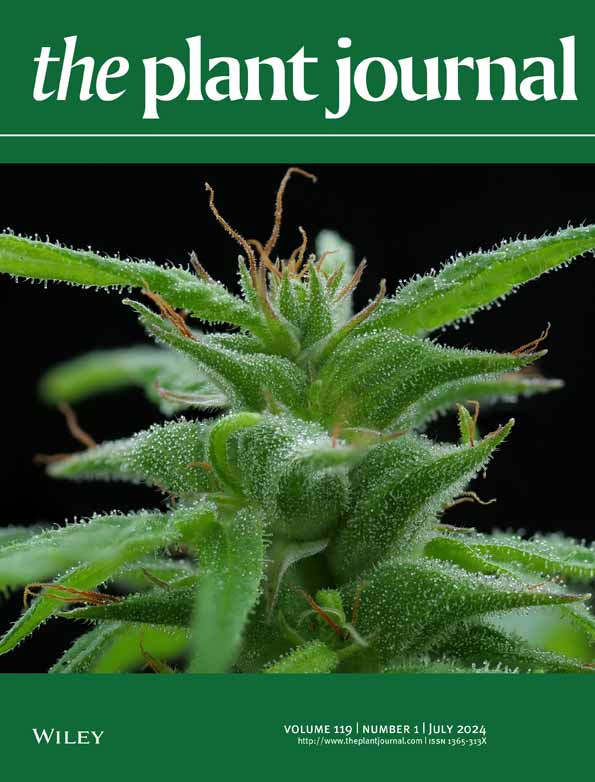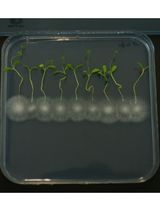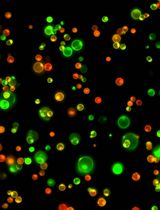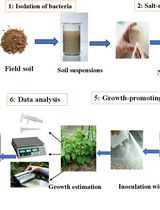- EN - English
- CN - 中文
Workflow for a Functional Assay of Candidate Effectors From Phytopathogens Using a TMV-GFP-based System
基于TMV-GFP系统的植物病原菌候选效应子功能筛选流程
发布: 2025年04月20日第15卷第8期 DOI: 10.21769/BioProtoc.5287 浏览次数: 1194
评审: Anonymous reviewer(s)
Abstract
The ability to efficiently screen plant pathogen effectors is crucial for understanding plant–pathogen interactions and developing disease-resistant crops. Traditional methods are often labor-intensive and time-consuming. Here, we present a robust, high-throughput screening assay using the tobacco mosaic virus–green fluorescent protein (TMV-GFP) vector system. The screening system combines the TMV-GFP vector and Agrobacterium-mediated transient expression in the model plant Nicotiana benthamiana. This system enables the rapid identification of effectors that interfere with plant immunity (both activation and suppression). The biological function of these effectors can be easily evaluated within six days by observing the GFP fluorescence signal using a UV lamp. This protocol significantly reduces the time required for screening and increases the throughput, making it suitable for large-scale studies. The method is versatile, cost-effective, and can be adapted to effectors with immune interference activity from various pathogens.
Key features
• A robust, cost-effective, and high-throughput functional screening system for plant pathogen effectors.
• Utilizes the TMV-GFP vector for rapid monitoring of effector activity.
• Evaluates the function of effectors within a few days using just a UV lamp.
• Adaptable to both apoplastic and cytoplasmic effectors from various phytopathogens.
Keywords: Virulence (毒力)Background
Understanding the molecular mechanisms of plant–pathogen interactions is essential for developing disease-resistant crops [1–3]. Traditional screening methods for plant pathogen effectors are often laborious and time-consuming, limiting their application in large-scale studies [4–8]. The tobacco mosaic virus (TMV) is a well-known positive-sense single-stranded RNA virus that can infect numerous plant species. Researchers have developed a TMV-based vector that expresses green fluorescent protein (GFP) to visualize viral movement. Under UV light, GFP fluorescence allows for easy tracking of the virus's spread [9]. When the TMV RNA is transcribed from the T-DNA, the vector begins to self-replicate and produces GFP. Consequently, the GFP fluorescence intensity provides a dependable measure of the TMV population size. The TMV-GFP vector system offers a robust approach, allowing for high-throughput screening of pathogen effectors. In this study, we took advantage of the TMV-GFP vector, established a TMV-GFP system, and demonstrated that it can be used to identify both functional cytoplasmic and apoplastic effectors from different plant pathogens based on TMV multiplication [9–11]. In our system, it is unnecessary to insert the effector gene into the TMV-GFP vector, overcoming size constraints about inserting foreign fragments when using a virus-based expression vector. Agrobacteria harboring the effector binary vector and the TMV-GFP vector were solely mixed before infiltration, and TMV infection was easily evaluated by observing the GFP fluorescence signal using a UV lamp within only a few days [12]. As such, as long as you already have an effector’s binary vector library, this functional screening assay can be easily initiated. The protocol described here is optimized for Nicotiana benthamiana but can be adapted to other plant species and pathogens. This method streamlines the screening process, significantly reducing the time and labor required, and provides a versatile tool for plant pathology research.
Materials and reagents
Biological materials
1. Nicotiana benthamiana seeds
2. Agrobacterium tumefaciens strain GV3101 (pMP90)
3. Escherichia coli strain DH5a
Reagents
1. Sterile deionized water
2. Sodium chloride (NaCl) (Sangon Biotech, catalog number: A501218-0001)
3. Tryptone (OXOID, catalog number: LP0042)
4. Yeast extract (Sangon Biotech, catalog number: A515245-0500)
5. Agar (Solarbio, catalog number: A8190)
6. MES free acid monohydrate (MES) (Solarbio, catalog number: M8010)
7. Magnesium chloride hexahydrate (MgCl2·6H2O) (Sangon Biotech, catalog number: A601336-0500)
8. 3’,5’-Dimethoxy-4’-hydroxyacetophenone (acetosyringone; AS) (Sigma-Aldrich, catalog number: 2478-38-8)
9. Rifampicin (Sangon Biotech, catalog number: A600812-0025)
10. Gentamycin (Sangon Biotech, catalog number: A620217-0005)
11. Spectinomycin dihydrochloride pentahydrate (Sangon Biotech, catalog number: A600901-0005)
12. Kanamycin sulfate (Sangon Biotech, catalog number: A600286-0005)
13. Dimethyl sulfoxide (DMSO) (Solarbio, catalog number: D8370)
14. Potassium hydroxide (KOH) (Sangon Biotech, catalog number: A610441-0500)
Solutions
1. Antibiotic solution (see Recipes)
2. LB medium (see Recipes)
3. Agrobacterium infiltration buffer (see Recipes)
Recipes
1. Antibiotic solution
Prepare a stock solution of gentamycin (50 mg/mL), spectinomycin dihydrochloride pentahydrate (50 mg/mL), and kanamycin sulfate (50 mg/mL) in sterile distilled water and rifampicin (25 mg/mL) in DMSO. Store at -20 °C. Dilute 1,000× and add to the medium.
Note: Depends on the construct and Agrobacterium strain. In this experiment, the GV3101 (pMP90) strain was used, and the nuclear gene contained the screening tag, rifampicin resistance gene, and the Ti plasmid pMP90, which conferred gentamycin resistance to the GV3101 strain. Also, different constructs have different screening tags; for example, the main construct used in this experiment is pGWB505, which has a spectinomycin dihydrochloride pentahydrate resistance. Therefore, media containing different antibiotics was used to grow the Agrobacterium needed for the experiment.
2. LB medium
Tryptone 10 g
NaCl 5 g
Yeast extract 5 g
Adjust pH to 7.5 with KOH and add sterile deionized water to 1 L. To prepare solid medium, add 15 g of agar to 1 L of medium and autoclave.
3. Agrobacterium infiltration buffer
1 M MES 100 μL
1 M MgCl2 100 μL
150 mM AS 10 μL
Add 9.790 mL of sterile deionized water to reach 10 mL.
Adjust MES to pH 5.7 with KOH.
Note: Dissolve MES and MgCl2 in sterile water and filter the solutions with a 0.22 μm syringe filter to avoid contamination. Store the solution at 4 °C. Dissolve AS in DMSO and store the stock solution at -20 °C.
Laboratory supplies
1. Soil mix or substrate (potting soil and vermiculite)
2. Plastic cups (8 cm diameter and 10 cm height)
3. Plant trays
4. Syringes (1 mL)
5. Tissue paper
6. Petri dishes (60 mm diameter)
7. 1.5 and 2.0 mL tubes (BBI, catalog number: F600620-0001)
8. Pipette tips (AIBIO, catalog number: T1040000)
9. Medical rubber gloves
10. Metal beads (3 mm)
Equipment
1. Plant growth chamber at 24 °C under a light intensity of 150 μmol·m-2·s-1 and a 16/8 h light/dark photoperiod
2. Spectrophotometer capable of OD600 measurements (e.g., Shimadzu, catalog number: 206-67001-34)
3. Petri dish incubator at 28tri (Panasonic, model: MIR-262-PC)
4. Handheld UV lamp (BLAK-RAY B-100AP LAMP, UVP, USA)
5. Digital camera (Canon, model: EOS 200D II)
Software and datasets
1. ImageJ (https://fiji.sc/)
2. GraphPad Prism 8 (http://www.graphpad.com)
Procedure
文章信息
稿件历史记录
提交日期: Dec 30, 2024
接收日期: Mar 18, 2025
在线发布日期: Apr 1, 2025
出版日期: Apr 20, 2025
版权信息
© 2025 The Author(s); This is an open access article under the CC BY-NC license (https://creativecommons.org/licenses/by-nc/4.0/).
如何引用
Cao, P., Shi, H., Chen, J., Cui, L., Zhang, M. and An, Y. (2025). Workflow for a Functional Assay of Candidate Effectors From Phytopathogens Using a TMV-GFP-based System. Bio-protocol 15(8): e5287. DOI: 10.21769/BioProtoc.5287.
分类
植物科学 > 植物免疫 > 宿主-细菌相互作用
植物科学 > 植物免疫 > 病害症状
微生物学 > 微生物-宿主相互作用
您对这篇实验方法有问题吗?
在此处发布您的问题,我们将邀请本文作者来回答。同时,我们会将您的问题发布到Bio-protocol Exchange,以便寻求社区成员的帮助。
提问指南
+ 问题描述
写下详细的问题描述,包括所有有助于他人回答您问题的信息(例如实验过程、条件和相关图像等)。
Share
Bluesky
X
Copy link












